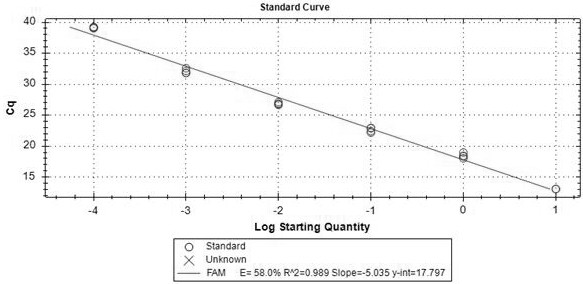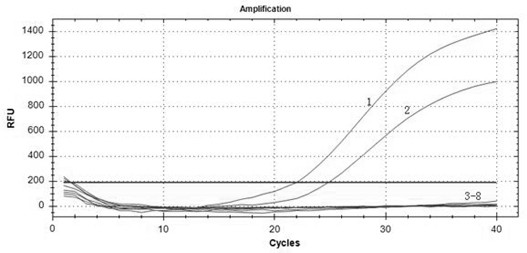Primers, probe, kit and method for detecting lycoris radiata mealybug based on fluorescent quantitative PCR
A technology for quantification of Lycoccus lycoccus and fluorescence, which is applied in the field of molecular biology, can solve the problems of gel product pollution, lack of specificity, cross-contamination, etc., and achieve the effects of avoiding confusion, strong specificity, and avoiding pollution
- Summary
- Abstract
- Description
- Claims
- Application Information
AI Technical Summary
Problems solved by technology
Method used
Image
Examples
Embodiment 1
[0030] Example 1: DNA Extraction
[0031] The above six kinds of adults were used for DNA extraction. The cotton mealybug was put into a mortar, and liquid nitrogen was added to grind it into a powder. DNA extraction was performed using the DNeasy® Tissue Kit from QIAGEN, Germany. For specific steps, refer to the kit instructions.
Embodiment 2
[0032] Embodiment 2: target sequence selection
[0033] mtDNA of P. amaryllis COI The sequence of the gene is analyzed, and the sequence fragment with a higher mutation rate is selected as the target fragment for amplification. Several sets of real-time fluorescent quantitative PCR primers and probes were designed. After preliminary screening, a set of fluorescent quantitative PCR primers and probes for detecting P. amaryllis was finally determined.
Embodiment 3
[0034] Example 3: Specific Primer and Probe Design
[0035] like figure 1 As shown, for the group, design the upstream primer PsF1, the downstream primer PsR1, and the specific probe as PsProbe,
[0036] PsF1:5'-TAGATTCTGACTTCTTTTTACCTTCT-3',
[0037] PsR1: 5'-TTAAGGTAATAAAATTTTGATT-3', the length of the amplified product of PsF1 / PsR1 is 125bp;
[0038] PsProbe: 5'-ATACAGGTTGAACTTTATATCCTCCTT-3', the 5' end of the probe is labeled with a FAM reporter fluorescent group, and the 3' end is labeled with a BHQ1 quencher group.
[0039]The probe PsProbe is an oligonucleotide probe with a fluorophore attached to the 5' end of the probe and a quencher at the 3' end. When the probe is intact, the fluorescent signal emitted by the reporter group is absorbed by the quencher group; during PCR amplification, the primers and P. amaryllis mtDNA complete the thermal cycle of high temperature denaturation, low temperature annealing and extension, and follow the polymerase chain reaction T...
PUM
 Login to View More
Login to View More Abstract
Description
Claims
Application Information
 Login to View More
Login to View More - R&D
- Intellectual Property
- Life Sciences
- Materials
- Tech Scout
- Unparalleled Data Quality
- Higher Quality Content
- 60% Fewer Hallucinations
Browse by: Latest US Patents, China's latest patents, Technical Efficacy Thesaurus, Application Domain, Technology Topic, Popular Technical Reports.
© 2025 PatSnap. All rights reserved.Legal|Privacy policy|Modern Slavery Act Transparency Statement|Sitemap|About US| Contact US: help@patsnap.com



